| Non-Ruminant Artiodactyls |
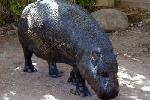 | Pygmy hippos are about half the size of regular hippos. They are native to Africa, like all hippopotami, and stand about 3 feet tall. Although most artiodactyls have hooves, hippos have toes. Four of them on each foot. Their wide feet help them navigate in the mud. Hippos are very territorial, sweat red, and are responsible for many deaths in Africa. |
 | Peccaries are like very hairy pigs. They are wild and are native to the Americas. They tend to be leaner than their domesticated cousins and like warm climates. They are considered primitive, but don't let that fool you. They are more common in the fossil record than in the modern world, but they are surviving nicely. Most peccaries live in herds or packs. They are social and vegetarian (almost). They occasionally snack on bugs. This is an interesting group. |
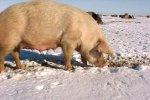 | Domestic pigs have been close associates of humans for at least seven thousand years. Pigs were useful because they provide food and natural recycling. They are omnivores, and can live on the waste and garbage humans throw away. Pigs are often used in medicine because they have organs similar to those of humans. The're nearly hairless too. Don't be discouraged about the similarities though. Pigs are very intelligent animals, and aren't as messy as you've been led to believe. |
 | Warthogs are pretty much wild pigs. They have some similarities to peccaries, but these are natives of Africa. Characteristic of the warthog is the long tusks. They use these as a defense against predators. They get their name from the two bumps on their heads above their tusks. These were thought to be warts. Like all piggies, these are omnivores, but prefer plants. They are peaceful creatures, but will defend themselves if necessary. |
| Cud-Chewers (with toes) |
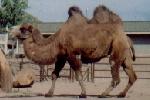 | There are two types of camels, the bactrian, or two-humped camels and the dromedaries, or one-humped camels. In case you can't count, the one in the picture is a bactrian. The two-hump camels are native to China and Mongolia, and the one-humped ones are from the western part of Asia. If you can't remember which is which, the letter B (for bactrian) turned on its side has two humps, and a D (dromedary) turned on its side has one. |
 | Essentially, llamas are small, humpless camels. They are used by humans in a variety of ways. They are pack animals which carry supplies. They are used for their milk, their wool and their meat as well. Llamas are gentle and hardy animals. They are used to rough terrain, so they don't get sick easily. They do spit however. It's their way of establishing their boundaries. And, by the way, if you go to a Spanish speaking country, it's pronounced yama. |
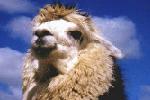 | Alpacas are close cousins to llamas, but they aren't as well known. They are natives of the Andes mountains and can be found in Chile, Peru and Bolivia. They, like the llamas, are decended from the guanaco, but they are smaller than llamas and stand less than a meter tall (about 3 feet). They are valued for their wool, which is reported to be very warm. |
| True Cud-Chewers (Hoofed) |
| Deer and their relatives |
 | Moose are the largest of the deer family. They're easily recognized with their large horns. In Europe, these same animals are called elk, and that can get confusing, since we give that name to a whole other animal. The American elk is actually a wapiti, but that name doesn't do the animal justice. Anyway, both of these are very large deer and are native to the U.S. |
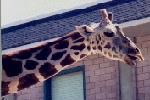 | Giraffes are the tallest of the animals. Although they look like horses that got stretched out, they aren't closely related to horses at all. They are considered deer-like. All giraffes are native to Africa and eat vegetation. There is a very silly anecdote about giraffes, and you'll hear a lot about them if you study the history of genetics. |
 | Caribou are also known as reindeer. These are large and well-suited to rough environment. They are capable of living in Alaska and northern Canada, and they are the only animal where both the male and female have antlers. These are also native to Siberia and are quite comfortable with the cold and snow. |
 | The first time I saw a Chinese water deer, I thought it must be the strangest animal. Its body looks like a deer, but it's only a little bigger than a hare. They run like rabbits too. On top of it all, they have large teeth which protrude from their mouths. Fangs! Rabbits with deer legs and fangs! I thought it may be the strangest animal I had seen, but nature has a way of making the unusual possible. They aren't the smallest hooved animals though. The mouse deer has them beat. |
| Bovines |
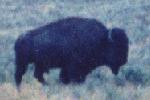 | Once, millions of bison roamed the great plains of North America, but they were nearly driven to extinction. At their low point, only a thousand were known to exist. They are doing much better now, and there are over 200,000. These are often called buffalo, but they aren't the same as the buffalo of Africa. |
 | Cape buffalo are African natives. They are close kin to domestic cattle, but are even closer to the familiar oxen. There are also oxen in Asia where they are used as draft (work) animals. Picture a large, horned, cow-like critter pulling a plow and you've got an ox, or a buffalo. |
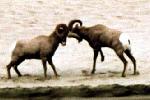 | The largest of all the wild sheep is the Rocky Mountain, or bighorn sheep. These are found all over the mountainous North America. These are closely related to domestic sheep, which aren't too distant from the goats. All of these are very important to humans for food, wool, and milk products. The bighorn sheep is notable for their ability to climb steep mountains and for the tough, curved horns which it uses for competition during the mating season. |
 | Domesticated cattle are as familiar a sight in the country as a barn or a horse. Cattle have been domesticated for thousands of years, and are very useful to humans. Female cattle are known as cows, and most of the West's dairy comes from a few breeds of cows. Cattle are also raised for meat, and those bessds differ from the breeds raised for milk. These modern cows have been carefully bred to be excellent milk or meat producers. |
 | Atrangely enough, antelope are not included in with the deer, but with the bovines. One impressive antelope is the impala. It is an African native and wanders in herds. Impala, as well as the other antelope, are primary consumers. They graze on vegetation, and are often the meal of the carnivores. |




 Artiodactyls are a familiar group. Surely you've seen cows, pigs, deer and maybe even a giraffe or two. These all belong to this wonderfully diverse group. Artiodactyls are even-toed ruminants. This means, first of all, they either have two or four toes on which they stand. We'll get to the ruminant part in a moment. Let's talk feet first.
Artiodactyls are a familiar group. Surely you've seen cows, pigs, deer and maybe even a giraffe or two. These all belong to this wonderfully diverse group. Artiodactyls are even-toed ruminants. This means, first of all, they either have two or four toes on which they stand. We'll get to the ruminant part in a moment. Let's talk feet first.














